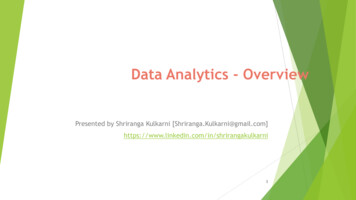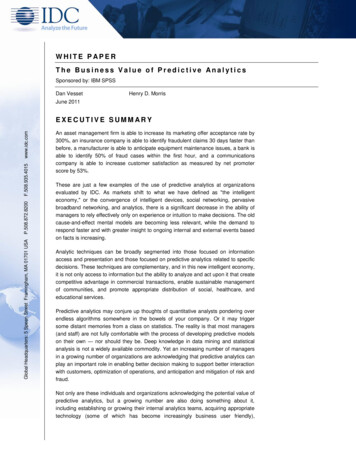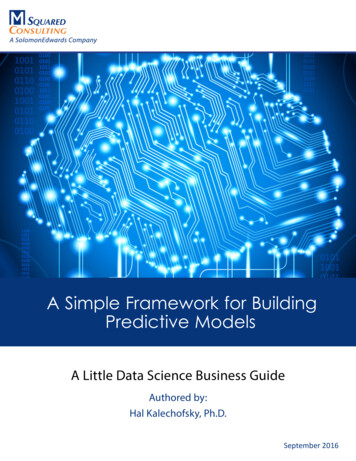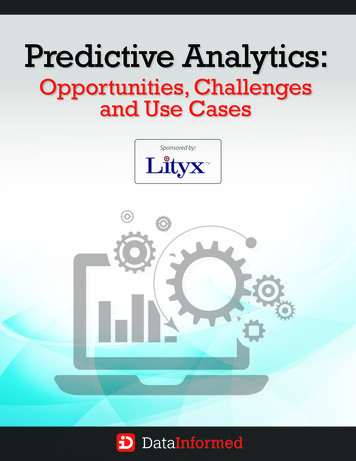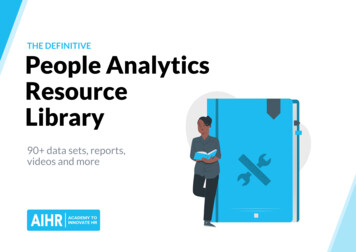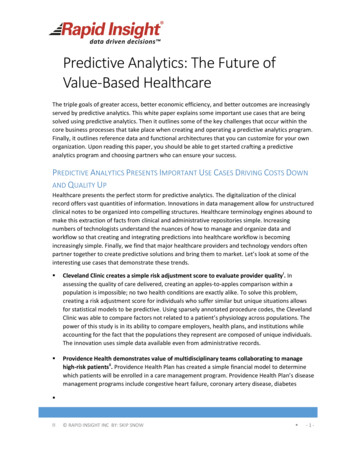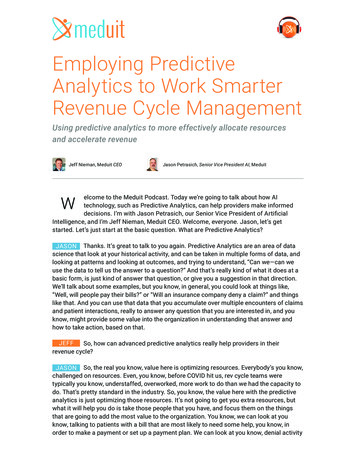
Transcription
Employing PredictiveAnalytics to Work SmarterRevenue Cycle ManagementUsing predictive analytics to more effectively allocate resourcesand accelerate revenueJeff Nieman, Meduit CEOJason Petrasich, Senior Vice President AI, MeduitWelcome to the Meduit Podcast. Today we’re going to talk about how AItechnology, such as Predictive Analytics, can help providers make informeddecisions. I’m with Jason Petrasich, our Senior Vice President of ArtificialIntelligence, and I’m Jeff Nieman, Meduit CEO. Welcome, everyone. Jason, let’s getstarted. Let’s just start at the basic question. What are Predictive Analytics?JASON Thanks. It’s great to talk to you again. Predictive Analytics are an area of datascience that look at your historical activity, and can be taken in multiple forms of data, andlooking at patterns and looking at outcomes, and trying to understand, “Can we—can weuse the data to tell us the answer to a question?” And that’s really kind of what it does at abasic form, is just kind of answer that question, or give you a suggestion in that direction.We’ll talk about some examples, but you know, in general, you could look at things like,“Well, will people pay their bills?” or “Will an insurance company deny a claim?” and thingslike that. And you can use that data that you accumulate over multiple encounters of claimsand patient interactions, really to answer any question that you are interested in, and youknow, might provide some value into the organization in understanding that answer andhow to take action, based on that.JEFFSo, how can advanced predictive analytics really help providers in theirrevenue cycle?JASON So, the real you know, value here is optimizing resources. Everybody’s you know,challenged on resources. Even, you know, before COVID hit us, rev cycle teams weretypically you know, understaffed, overworked, more work to do than we had the capacity todo. That’s pretty standard in the industry. So, you know, the value here with the predictiveanalytics is just optimizing those resources. It’s not going to get you extra resources, butwhat it will help you do is take those people that you have, and focus them on the thingsthat are going to add the most value to the organization. You know, we can look at youknow, talking to patients with a bill that are most likely to need some help, you know, inorder to make a payment or set up a payment plan. We can look at you know, denial activity
with insurances and understand, you know, “What is the probability that we’re going to beable to solve that denial and actually get that claim paid?” So, you know, if you order all ofthat work, you know, in your work queues based on the highest value, has potential valuefirst, you know, if you don’t have enough resources to get through your whole work list, thenyou know, the things that aren’t getting worked, are the ones with the least amount of value.You know, it—you know, might work on a denial that you know, very unlikely to ever win, andit’s going to end up being a write-off. You know, that can wait, right? There’s no urgencynecessarily to get that worked. You know, you want to focus on the cash and theresolutions, you know, throughout the revenue cycle.JEFFMeduit has developed predictive analytics tools under the MedProve SolutionsSet, and those cover Patient, Payer, and Charity components of the revenue cycle. So, let’stake each of those in turn. Tell us about how MedProve Patient works to benefit providers,and improve their bottom line.JASON Yes, absolutely. And we’ll get into some details here. And it’s important to notethat this—this kind of you know, tool, predictive analytics tools, are pretty common in theindustry. And you know, you don’t necessarily need to pay a huge amount of money to getaccess to these. You know, they’re pretty straightforward. You know, the real questionthough is, is “Can you take the action based on it?” And so, you know, you think aboutsomething as simple as, “Will a patient pay their bill or not?” You know, if you have youknow, a customer service team and they can only make, you know, 100 calls a day, youobviously want to focus those 100 calls on patients that are probably going to pay if youget them on the phone, and start talking to them about their bill. And like I said earlier, youwant to deprioritize you know, talking to the patients who probably aren’t ever going topay. You know, and the predictive analytics tools can help you kind of rank order that work,and understand that aspect. So, you know, in terms of customer service, and self-paycollections, it’s definitely focusing that outbound collection effort, you know, on the mostlikely candidate. So again, the values there are you know, you’re going to optimize thoseresources, because you’re going to increase the potential amount of cash that you’rebringing in, based on those contacts. And you know, overall, get through the populationthat actually needs to have that contact done.JEFFGreat. Tell us about MedProve Payer and how that helps create value.JASON So, it’s a similar concept, right? So, we’re trying to predict the behavior ofsomething, you know, that’s going to happen. And there’s a couple ways that you canapply MedProve Payer. You know, one of those would be just looking at the timing of whena claim gets paid. You know, legacy business office kind of processes, you know, you wouldfollow up on a claim every 30 days or every 15 days. You know, high dollar claims mightpull up on every 10 days, with the payer. And there’s a lot of you know, touchpoints in therewhere you’ve got a team member and a work queue, going through and trying to contactthat insurance and say, “Hey, do you have our claims?” and then process any issues withthat. But what if you could take the data on your payer behavior, and look at when theyrespond to those claims? And this could be really granular like, you know, ED claims aredifferent than you know, outpatient radiology, different than inpatient, you know, admissionclaims. All of those can tell you—all that data can tell you, “When are they going to
respond?” And so, here’s the value. So, let’s say, your business office process says, “I wantto follow up on a claim 14 days after it’s been submitted to the payer.” Well, if you look atyour data, and let’s say you know, United Healthcare pays those claims on Day 17. Well, ifyou try to call them at Day 14, all they’re going to get is, “Your claim’s in process. It’s goingto be paid in three days.” You know, if you adjust your resource timing so that you’re lookingat when you should have had a response from the payer, then you can actually optimize thatwork effort, because let’s say, you know, 80% of your claims get paid on Day 17. Okay, wellthen if you do your follow up work on Day 19 or Day 20, they you’re really only going to betouching like 20% of the volume, instead of 100% of the volume. So again, it’s about theoptimization of those resources. So, timing of when an insurance will respond to your claimcan help that kind of initial follow up activity in your business office. And another aspect ofMedProve Payer can actually look at denial recovery probability. You know, and I mentionedthis before, but you know, once a claim has a problem, obviously we have to work on tryingto resolve that, you know, whether we’re going to send a corrected claim, or whether wehave to do an appeal, or reconsideration form, or just fix something in the system, there’ssome action that has to be taken in order to try to resolve that within your AR. Now, we can. MedProve Charity is a little bit different. This is really aimedat organizations that have you know, a community benefit need,a 501(r) need.– Jason Petrasichapply the MedProve Payer models, and say, “Which ones are going to resolve to cash?” or“Which ones are going to resolve to adjustments?” And if you—again, if you’re prioritizingyour resources, you know, and you’re trying to drive your cash, you know, with fewerresources in the business office, you want to focus those ones on the things that we canfix, right? So, yes, we want to work every claim that’s denied in the inventory, but if you haveto put them in order, you want to work the ones that are going to generate cash first, andyou want to work the ones that are going to generate a write-off last. And again, so asyou—if you run out of resources, or if it takes you a couple weeks longer to get throughthose claims, you know, you’re not affecting your cash flow in the organization. So, thoseare really the two dimensions of MedProve Payer: the timing and then you know, therecoverability of something that has a problem on it.JEFFYes, these first two are all about working smarter to really align your resourcesthat you have in the business office with the things that are going to get you the bestimpact. And I think, you know, most of us who have been in the business for years,may think from a gut perspective that we know how to do that, right? And we may bedirectionally right, but taking a data-driven approach certainly provides certainty andprecision and the level of effectiveness that you can have with workflow optimizationand prioritization of the work to get done.JASONAbsolutely.
JEFFSo, tell us about the last one, MedProve Charity.JASON So, MedProve Charity is a little bit different. This is really aimed at organizationsthat have you know, a community benefit need, a 501(r) need. You know, we all know thatpatients that go through the emergency departments, are you know, usually lower income,sometimes indigent, and also not really very cooperative with our processes to contactthem and talk to them. All hospitals have a proactive financial assistance program whereif somebody says, “Hey, I need help with my bill,” you have an application, you fill it out,you meet the criteria, you qualify for it. But that really only works if the patient’s activelyengaged. What we’ve seen is that you know, a large portion of that population, thatuninsured population that comes through, they’re apathetic. They really don’t care. Theydon’t want to spend any time talking to you about filling out an application form. Andthey really don’t want to necessarily participate in that process. But you know, from acommunity benefit perspective, you know, if we can use data analytics to understandwhether that patient is indigent, you know, that can still be qualified for presumptive charityunder your financial assistance policy. And then that can be counted as a communitybenefit for 501(r). So, what we can do here is look at you know, census, block level, data,some demographics data, just to understand kind of—get a picture of, “Where does—where’s that person live? You know, what’s the average household income in that area?”And we can actually calculate an estimated federal poverty limit level for that patient.You know, if your hospital says, “Patients under 200% of the FPL can have 100% charitywrite-off,” then we can actually use this presumptive score. We can say, you know, “Wenever talked to this patient directly, but using all of our data analytics, we were able todetermine that this person is likely below that 200% threshold. And so, we’re going toqualify them as Presumptive Charity.” So, again, you know, this is really aimed at you know,kind of streamlining that business process. You know, we would recommend that youknow, you do this kind of after your pre-collection process, your early out process, whereyou send statements to the patient, you try to generate that contact. Because if somebodywants to pay, or set up a payment plan, you want to give them that opportunity. And wewould suggest that you apply MedProve Charity really at the point of kind of pre-bad debt.Right when you’re ready to transfer to bad debt. You know, presumptive charity and baddebt are both uncompensated care, so there’s no real P and L difference to classifysomething as presumptive charity versus bad debt. You know, so it’s really back to thatcommunity benefit. You know, you’re not going to send somebody to collections who’snever going to pay, in bad debt. You’re going to route them into that charity program andyou’re going to capture that benefit for your organization. So, from a timing perspective,we would do this right before an account goes to bad debt, and you’re diverting thoseaccounts. Instead of going to the collection agency, they’ll go into the presumptive charitywrite-off bucket for your organization.JEFFThanks for those explanations, Jason. I know Meduit just conducted a casestudy to test the efficacy of the MedProve set of solutions. So, tell us a little bit aboutthat case study.JASON Yes, absolutely. This is really exciting. And you know, we love to be able toshow you know, real world use cases where we’ve applied MedProve solutions in orderto optimize the value. And this particular one was around patient propensity to pay and
optimizing the resources for those contacts that I talked about earlier. You know, we wereable to generate an 18% in—you know, increase in recovery rates over you know, severalmonths’ period of refocusing that work effort. You know, and we changed the way the dialercampaigns were working for these clients. We were pulling these calls and prioritizingthem. You know, and then also you know, managing the contact process throughout thatwith you know, ensuring that we’re not calling them too many times, and we’re also notneglecting the rest of the population, right? So, we’re just optimizing those calls of patientsand trying to drive that—that higher collection. Then what we found in that result is a prettymaterial increase in generating cash. And again, that’s through taking that limited amountof resources that you have to create contacts, and focusing on the best opportunities.JEFFFor more information about the MedProve Suite of Predictive Analytics, howwould a provider contact Meduit AI?JASON The best way to reach us is to hit up our website at meduitrcm.com. Just click onthe Contact Us link on there. Give us a little bit of contact information for you, and we’ll havesomebody reach out to you. And we’ll be more than happy to talk to you about predictiveanalytics and how those can help you know, optimize the resources in your organization.JEFFAlright. Thanks, Jason. And thanks listeners for joining us today. Hope youfound our podcast series informative and helpful in accelerating your revenue cycle.Jeff Nieman, Meduit CEOMr. Nieman leads Meduit’s top-notch team of healthcare revenuecycle professionals to maximize performance and accelerate growthfor hospitals, health systems and provider groups. Prior to joiningthe Meduit team, he was the chief operating officer for NavigantCymetrix, a revenue cycle management company serving over 200hospitals. He has also held leadership positions at Conifer Health Solutions, Humanaand HCA (Hospital Corporation of America) and has a BA in economics from BellarmineUniversity in Louisville, Kentucky where he graduated Magna Cum Laude.Jason Petrasich, Senior Vice President AI, MeduitMr. Petrasich drives revenue cycle solutions powered by artificialintelligence (AI) that support healthcare providers’ operational, clinicaland financial health. Petrasich brings over 25 years of RCM experiencein revenue cycle process design, efficiency and resource optimization.Prior to joining Meduit, he served as national vice president of revenuecycle for Prospect Medical Holdings, Inc., vice president of operations for NavigantCymetrix, and senior director of operations planning for Conifer Health Solutions. Heearned his Master of Business Administration from Pepperdine University.
Employing Predictive Analytics to Work Smarter Revenue Cycle Management Using predictive analytics to more effectively allocate resources and accelerate revenue elcome to the Meduit Podcast. Today we’re going to talk about how AI technology, such as Predictive Analyt
